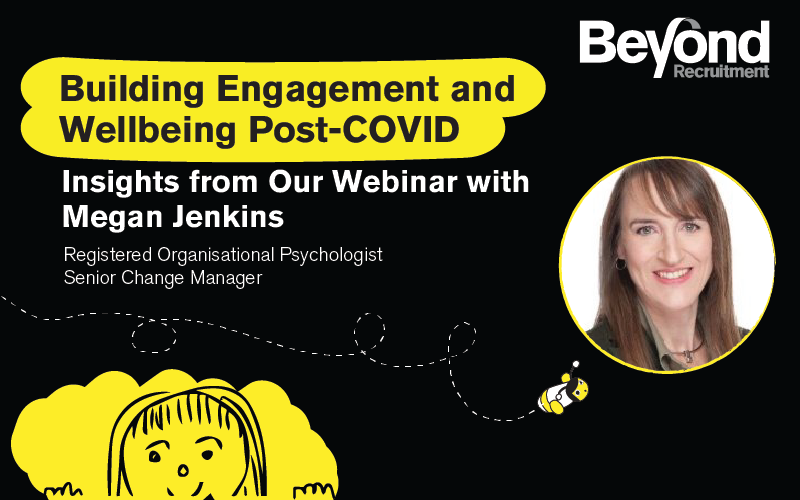COVID changed the workplace climate for business leaders and these profound workplace changes have brought challenges to the table. These challenges have included managing people returning to the workplace post-lockdown and leading teams and company culture in a new hybrid way of working. When you combine this with talent leaving their roles at record rates, employers have a unique set of circumstances to navigate.
On top of this, the focus on mental well-being has increased significantly and this has created pressure that didn’t previously exist. So, how do we navigate through these times and how do leaders grappling with the new paradigm seek answers to balancing the equilibrium while taking care of employee wellbeing? In our recent webinar, Senior Change Manager and Registered Organisational Psychologist, Megan Jenkins, explored tips for businesses and leaders to build resilience, engagement and wellbeing.
As we continue to experience a period of unpredictability, here is a summary of the key insights from the webinar to help you navigate building engagement and wellbeing post-COVID.
Explaining Stress and Wellbeing
COVID has triggered many different changes in the workplace and everyone is still getting used to this process. These changes can create stress and when this happens our central nervous system puts us into a fight, flight or freeze mode. This presents a physical and emotional response to that change that can be tough to navigate.
Created by psychiatrist Elisabeth Kubler-Ross, the Change Curve is a popular model that is widely used in business and change management to understand how people react to change and ensure they have the support and guidance they need. Our aims should be to activate the parasympathetic nervous system, to ‘rest and digest’ to be back at our best, both for our bodies, and for optimal thinking and decision making.
Research on Engagement and Motivation
The Hawthorne Studies researched what would be the optimum environment for people to operate and this later became known as the Hawthorne Effect. In this case, they researched lighting levels in a factory to help workers to be productive, but it can be applied to almost anything when it comes to ensuring productivity and efficiency in employees.
It comes down to how people perceive themselves and how they matter in their role, and how employers can make a better environment and workplace culture for them. This includes using different motivators for both intrinsic (meaning, perceived value) and extrinsic motivation (rewards, praise). The research has grown to include current research from Morrison and Macky who determined an open plan office showed managers less inclined to be supportive, with employees finding it unpleasant and more distracting. Other research from Smollan, Cooper-Thomas and Morrison determined that COVID-19 has raised workloads when working from home (possibly due to difficulty separating work from home) and made communication difficult with hybrid working.
Tips for Businesses and Leaders
There are some simple steps discussed to build change resilience and improve engagement in employees. With the right support, employees can move forward and employers can consider more solutions to help them to be more comfortable and focused on their roles.
When employers help their teams to uncover how they feel and the way they react to change, they can work together to tackle what they can control. Some of the tips discussed include:
Encouraging micro and macro breaks from the desk
Working on reducing poor culture that erodes employee trust
It's not a one-size-fits-all solution to getting everyone back to the office or work from home; working with your employees will empower them to make the right decision to optimise productivity, and improve motivation and engagement.
Find Out More
This is just a glimpse of what Megan Jenkins covered in the webinar – we encourage you to click below and view the recording and presentation slides to get a full picture of her insights on this pertinent topic.

If you would like to discuss any of these points or find out how we can support you and your business during this time, please don’t hesitate to reach out.





